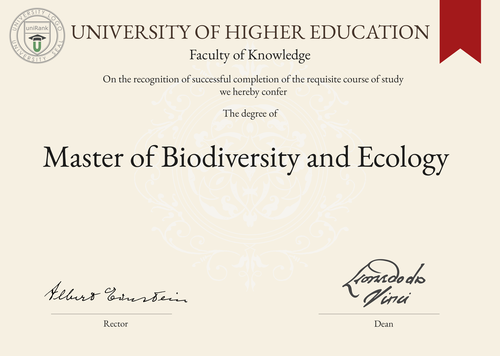
Master of Biodiversity and Ecology (MBE)
Guide to Master of Biodiversity and Ecology Program/Course/Degree
Master of Biodiversity and Ecology (MBE)

Program Name:
Master of Biodiversity and EcologyProgram or Degree abbreviation:
MBEDuration range:
Varies by country and universityTuition range:
Varies by country and universityOverview:
The Master of Biodiversity and Ecology (MBE) program is designed to provide students with a comprehensive understanding of biodiversity and its ecological significance. This program combines theoretical knowledge with practical fieldwork, allowing students to develop skills in biodiversity assessment, conservation and management.Curriculum Overview by year:
The curriculum of the MBE program is structured to cover various aspects of biodiversity and ecology. In the first year, students typically study foundational courses such as Biodiversity Conservation, Ecological Research Methods and Ecosystem Dynamics. In the second year, students have the opportunity to specialize in areas such as Conservation Biology, Wildlife Management, or Ecological Restoration.Key Components:
The key components of the MBE program include fieldwork, laboratory research, data analysis and conservation planning. Students gain hands-on experience through field trips, internships and research projects, allowing them to apply their knowledge in real-world scenarios.Career Prospects:
Graduates of the MBE program have diverse career prospects. They can work as biodiversity researchers, conservation officers, environmental consultants, wildlife biologists, or educators. Employment opportunities can be found in government agencies, non-profit organizations, research institutions and environmental consulting firms.Salary Expectations:
Salary expectations for MBE graduates vary depending on factors such as location, job position and level of experience. Generally, professionals in this field can earn competitive salaries, with the potential for growth as they gain more experience and expertise. For a more accurate understanding of salary expectations, you can utilize the Job Sites Search Engine, from our sister site jobRank, which searches over 4,600 job sites worldwide. Make sure to specify not only the job title but also the country you are interested in.Conclusions:
It is important to note that the duration, tuition fees, curriculum, key components, career prospects and salary expectations of the Master of Biodiversity and Ecology program can vary based on the chosen country or location of study, as well as the specific university offering the program. Prospective students are encouraged to research and compare different universities and countries to find the best fit for their academic and career goals. Visitors interested in pursuing the Master of Biodiversity and Ecology degree can utilize the uniRank World Universities Search Engine to explore universities worldwide that offer this program. This search engine provides a comprehensive database of universities, allowing individuals to find the most suitable options for their desired degree.World Universities Search Engine
search for Master of Biodiversity and Ecology (MBE) and add the Location (country, state etc.) or specific University you are interested in studying at.
Query examples:
- Master of Biodiversity and Ecology (MBE) United States
- Master of Biodiversity and Ecology (MBE) United Kingdom online
- Master of Biodiversity and Ecology (MBE) Australia international students
- Master of Biodiversity and Ecology (MBE) University of California
- Master of Biodiversity and Ecology (MBE) University of London tuition fees
- Master of Biodiversity and Ecology (MBE) University of Sydney scholarships
Share Program/Course
Interesting? Share this program/course/degree info with your friends now.